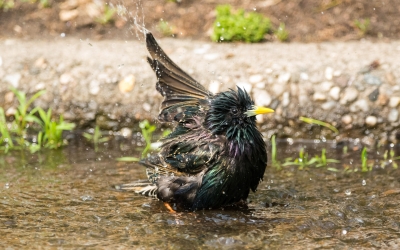
Migration pattern
The impact of climate change on birds’ migration patterns has been noticed in the last few decades. Scientists have documented that fewer birds show up in breeding and wintering grounds and they attribute it to the increasing temperatures changing vegetation and extreme weather conditions.
Birds synchronise their migratory movements with seasonal changes. The start of their journey and their speed must match the life cycle (before caterpillars pupate) of food sources at the stopover and destination sites. But these environmental cues go for a toss with changing climate.
Lack of food
A number of birds has adjusted breeding times to match early Spring. They arrive at the breeding site earlier than before. Meanwhile, increasing temperatures also make the vegetation bloom and insects hatch earlier at the site. But sometimes these shifts are not in line with each other. As a result, the chicks hatch way after the caterpillars are gone. And so, they starve. (On average the window of time when birds lay their eggs has gotten earlier by almost two weeks over half a century. Since many small songbirds can raise their young in roughly one month, two weeks is a big shift in their timing.)
Habitat loss
One of the major effects of climate change is the loss of habitats. While some species face shrinking ranges, others face habitat destruction. For migrating birds, flooding or desertification could spell doom. Flocks might fly thousands of kilometres only to find their destination submerged or barren. Many goose species use the Siberian tundra’s rocky bedrock to raise their offspring. But increasing temperatures make the permafrost soil to thaw and change the habitat completely, making it impossible for the geese to breed.
Sea-level rise
Sea-level rise and erosion alter coastal wetlands. Many birds, such as piping plovers, that inhabit coastal areas lay their eggs directly on the sand of the beach in a shallow depression. The erosion of beaches and storm surges can cause nests to be lost to the ocean.
Lack of sea ice
Climate change affect penguins in two ways – non-availability of food and nesting habitats. The Adelie penguins nest on land during the summer, and migrate during the winter to the edge of the sea ice, where they feed at sea. As icebergs break off in warming Antarctica, Adelie penguins are forced to take longer routes to find food in the ocean.
Antarctica’s climate is generally cold and dry but warming could cause unprecedented rain or melting of ice, creating puddles on the ground. This is bad news for penguins that lay their eggs on the ground. Their eggs cannot survive when they are lying in a pool of water.
Chinstrap penguins, which also breed in Antarctica, are affected by melting ice. Lack of sea ice affects the abundance of krill their main source of food.
Smaller body, larger wings
A study published in December 2019 found that global warming was causing birds to shrink and their wingspans to grow in size. Scientists explained that it could be more adaptation of birds as smaller birds are better at cooling off, losing body heat more quickly due to their larger surface area to volume ratios. But smaller body size means less energy available for the birds to complete long journeys. Scientists say that birds would have evolved to grow long wings to compensate for their smaller bodies as it helps them survive migration.
Will birds be able to adapt to climate change?
In the past, species and ecosystems were able to respond to global temperature shifts because average global temperatures changed slowly. Now, the change is simply too fast for many species to adapt. As we saw earlier, birds are adapting ways such as starting their migration early to match earlier Springs, but scientists are not sure if they will be able to keep up with the speed of climate change.
Picture Credit : Google
